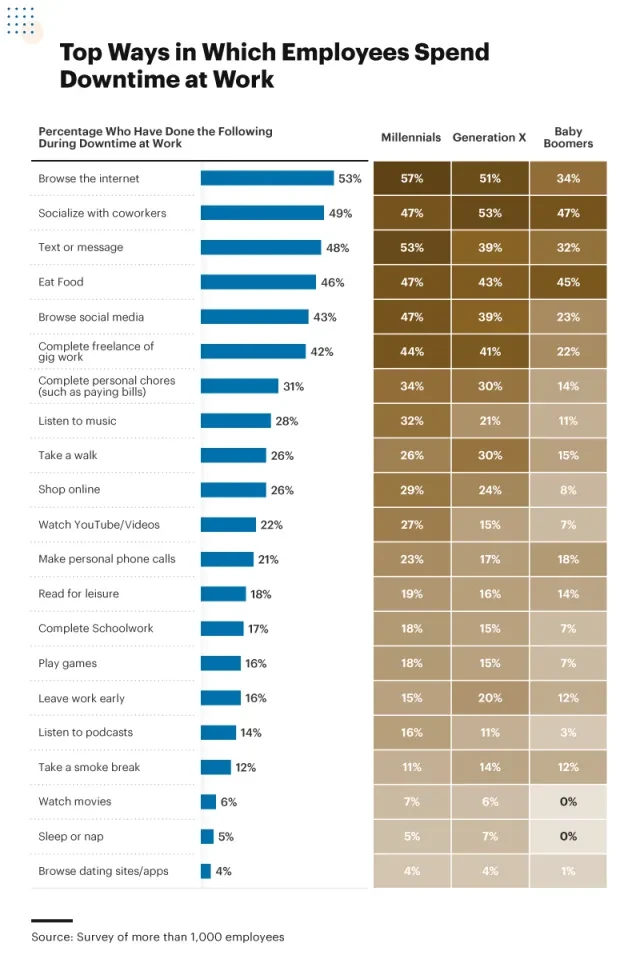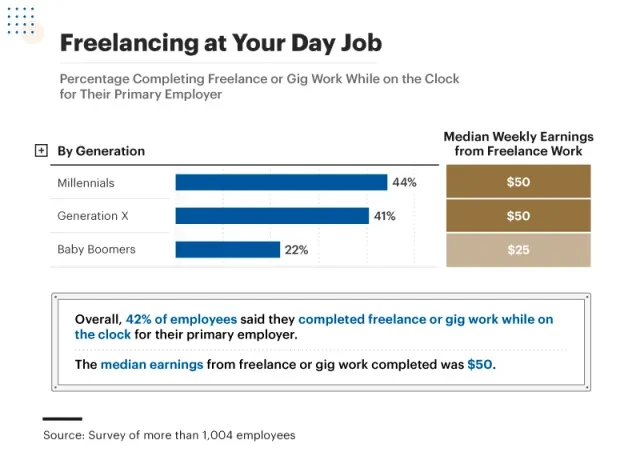- Recursos humanos
- Artículo
- Lectura de 6 minutos
- Last Updated: 02/24/2020
Lost Minutes: Exploring Worker Downtime

Table of Contents
The average professional clocks over 40 hours weekly at the office — with many working even more grueling schedules. But even if you’re putting in long days, how much of your time is actually spent working?
Some research suggests workers devote just a fraction of their days to real productivity, unable to focus for hours on end. In an era of digital distraction and appealing office amenities, how are employees utilizing their downtime and ultimately who is responsible for the downtime you have at work? In a previous survey, we found that a “lack of work” was the number one reason employees were wasting time at their job.
To explore this further, we conducted a follow-up survey to determine the ways in which a lack of work may influence the average employee’s day. A total of 1,004 professionals from a diverse array of fields and demographic groups were surveyed. We asked them about the amount of downtime they get at their jobs and what they do with it. For a look at downtime in American offices, keep reading.
Downtime data
According to our results, downtime accounted for nearly a quarter of the average worker’s day. Yet, respondents’ experiences varied widely: While most professionals reported an hour or less of downtime daily, 20% reported three or more hours of spare time each day. While these contrasts likely reflect industry differences, they may also relate to the uneven adoption of employee monitoring tools. Some companies track their workers’ every move, while others have chosen not monitor staff in this manner.
On the subject of accountability, remote workers averaged 20 more minutes of downtime per day than in-office professionals.
Most workers felt they had either enough downtime or too little. Just 18% said they had too much — and with over three hours of downtime, on average, this group had good reason to say so. First-year employees were the most likely to say they had a lot of downtime, suggesting that entry-level positions are often less demanding or have less responsibilities since many employees acquire additional duties with tenure. But among workers with six or more years at their companies, 20% reported having plenty of downtime as well. More experience could lead to efficiency.
Why time gets wasted
Most respondents were at least somewhat accountable for the downtime they experienced. Thirty-six percent said they were primarily responsible, while another 28% said they shared responsibility with their employer. But in citing specific reasons for their spare time at the office, many respondents said there was no more work to do — even if they wanted it.
Forty percent of respondents said they had downtime because they sped through their duties and then found themselves with nothing left to do. Another 37% said their workflows were inconsistent, while 20% said there wasn’t enough work to go around.
These conditions could stem from overstaffing, indicating that the number of resources isn’t in line with amount of work. But managers can be fearful that departures will undermine company morale. In fact, workers were more likely to leave a job due to excessive downtime than to be terminated for it. This finding affirms that boredom and lack of engagement can contribute to attrition.
Of course, many employees were more than willing to savor their downtime: 31% said they chose to make downtime during the day, and 23% explained that their work wasn’t urgent. Moreover, 13% admitted they could ask to take on more tasks but chose not to.
Downtime activities
Browsing the internet was the top downtime activity among professionals — and especially common among millennial workers. Similarly, 43% admitted to browsing social media, while 26% reported shopping online. These activities can be considered modern ways to waste time, but they also reflect employers’ monitoring blind spots: Although many businesses review employees’ emails, most don’t scrutinize workers’ browsing habits.
More social downtime activities were also quite common, with 49% stating they talked to co-workers. Similarly, 48% reported texting or messaging during spare moments. Interestingly, Gen Xers were the most likely to do their socializing with colleagues in person, while millennials were more inclined to chat by text.
A quarter of employees admitted to doing work during their downtime — although not for their primary employer. As freelancers and the gig economy have become established factions of the labor market, employers are likely to confront this challenge with increasing frequency. Millennials were the most likely to engage in gig work during downtime, which could indicate that managing side hustles can be a significant source of distraction for this group of professionals.
Wishing for work?
When confronted with downtime, most employees requested more work in at least a few instances. But over a fifth of respondents said they never asked for more work to occupy their spare time. As one might expect, workers who “rarely” had downtime were more likely to savor it than those who had it “sometimes.” Yet, among those who “always” or “often” found themselves with downtime, 23% never asked for more work either.
Perhaps workers in this camp are wary of spoiling their lower productivity roles. But they could also be struggling with how to advocate for more responsibility, a challenging conversation for many professionals to broach with their managers.
Interestingly, entry-level employees were much less likely to feel guilty about downtime than those with seniority. In fact, among senior managers, 48% felt some degree of guilt about their downtime. Perhaps management positions confer a heightened sense of responsibility to both the people they manage and their own supervisors.
Conversely, our findings could indicate that people who feel guilty about downtime are more likely to ascend the corporate ladder. Executives viewed downtime in an especially negative light, with 47% agreeing that an employee with a lot of time on their hands was likely to be dispensable.
Slacking off, satisfaction, and salary
Is downtime a boon to workers, or a source of frustration? Employee satisfaction was the highest among people who said they had neither too little nor too much downtime. This finding could indicate that employees with ample downtime may not necessarily enjoy their open schedules. Indeed, some research suggests that professionals (particularly young ones) often seek new jobs because they feel underutilized in their current positions.
Additionally, having a job with a lot of downtime didn’t seem to improve people’s attitudes regarding their pay. One might attribute this to the pay grade for jobs that entail a lot of spare time.
Optimizing hours: focus and flexibility
A significant percentage of respondents said they spend hours each day disengaged from their work. But the issue of downtime isn’t strictly a matter of poor work ethics among professionals. Instead, the amount of spare time one has at work is a nuanced management question. Demand too little, and employers risk frustrating ambitious workers. Require total focus at all times, however, and companies may risk their best employees burning out.
Company leaders may consider addressing downtime directly, rather than assuming their teams are constantly productive. This approach may be a departure from established policies but could ultimately improve employee morale. When viewed as a means for workers to recharge, downtime can begin to seem like a vital resource, fueling workers’ capacity to perform sustainably.
As you engage these challenging but essential subjects, let us have your back. Paychex streamlines your HR and payroll needs through flexible, intuitive platforms — allowing you to stay focused on the big picture.
Methodology
We conducted an online survey of 1,004 Americans who were employed full time and asked them questions related to downtime at work. Downtime was defined for survey respondents as any period during working hours when there is no active work or project to complete.
Fifty-one percent of our respondents identified as male, 49% identified as female, and less than 1% identified as a gender not listed on our survey. Respondents ranged in age from 19 to 74 with a mean of 36 and a standard deviation of 10.1.
The amount employees are paid for downtime is based on the median weekly earnings from the U.S. Bureau of Labor Statistics and the average amount of downtime according to our survey.
Limitations
Average minutes of downtime were limited to respondents who indicated they had at least some downtime during their typical workday.
The data we are presenting rely on self-reporting and, as such, is susceptible to issues such as exaggeration or selective memory.
No statistical testing was performed. The claims listed above are based on means alone and are presented for informational purposes.
Fair use statement
Interested in sharing this project with friends, family, or colleagues? Feel free to do so (perhaps during some downtime at the office). In the interest of fair attribution, however, we do have two requests. First, please use our images and information only for noncommercial purposes. Second, please link back to this page whenever you share our work to credit our team appropriately.
Tags












